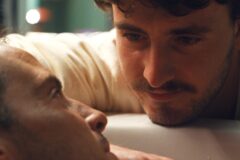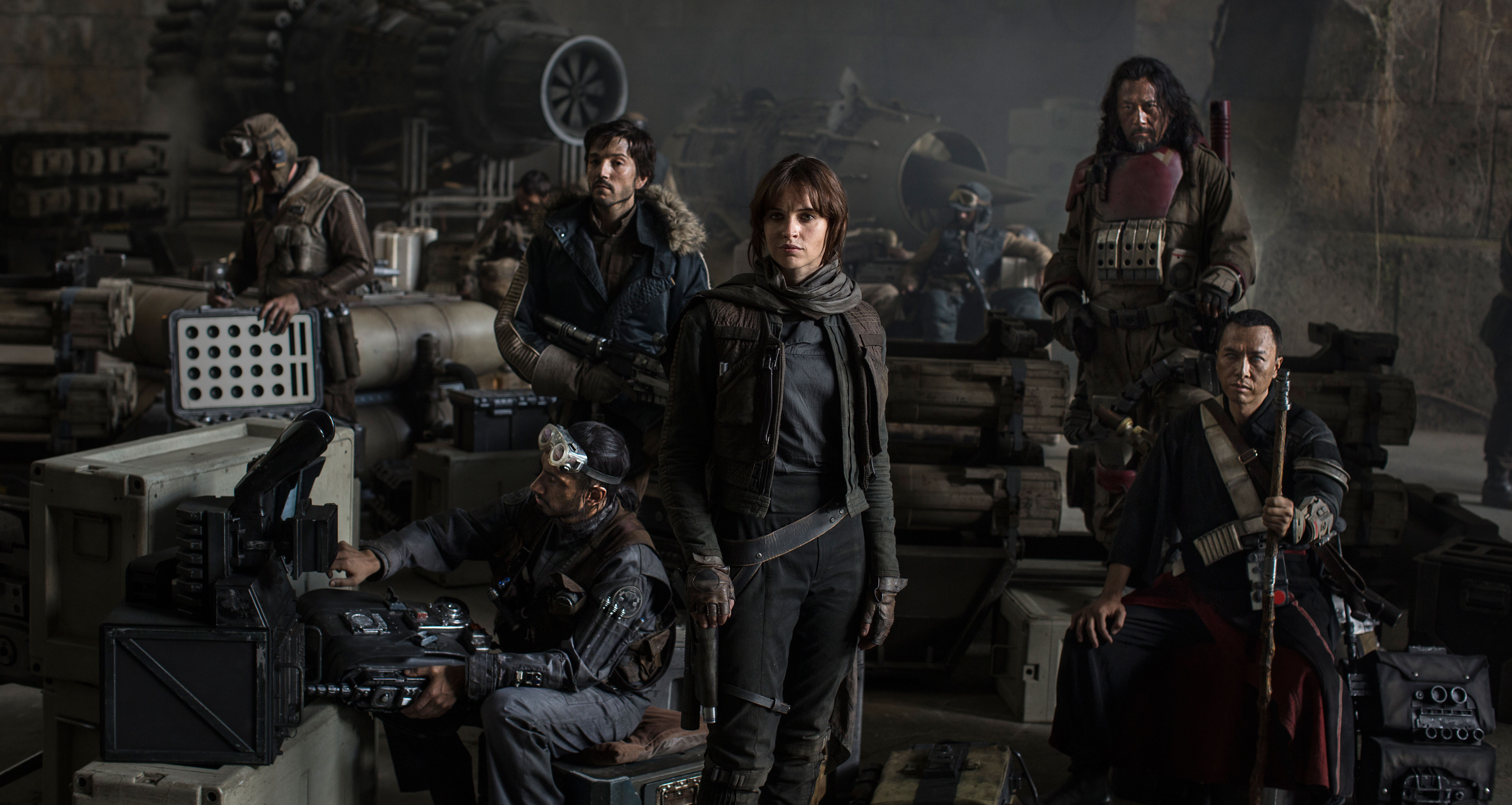The Force Awakens may have been the last Star Wars movie a multiplex audience claps for. I saw Rogue One: A Star Wars Story on the Thursday night before its official opening date, technically when the sweaty die-hards should have been gathering in hoards. But the Battery Park Regal cinema was strangely chill, getting a ticket the week before had been surprisingly easy, and my fellow moviegoers seemed more like finance bros kicking back after a day at the office than toy-lightsaber-wielding obsessives. (I was probably the only person in the theater who gasped when Jimmy Smits showed up.) Going to see another Star Wars film a year after the grand return of perhaps our most beloved modern film franchise kind of felt like seeing any old movie. There was no fanfare, and no great expectation. We’re officially in the era of Star Wars normalcy.
Rogue One is the second release in the potentially endless Disney-Lucasfilm era, so it’s probably time to change the yardstick by which we measure the franchise. The Force Awakens let us hold on to the belief that this franchise might still be a very rare golden goose whose eggs would all be of a recognizable lineage. That film, which took place 30 years after the events of Return of the Jedi and brought back all three of the original trilogy’s leads, was a reboot, and a relatively non-divisive one at that. Its responsibilities were wholly different from Rogue One, a semi-side-quel based on a notorious logistical quibble in the original 1977 Star Wars film. Rogue One exists not so much to repeat the past as to shade it in. Perhaps because of that, it’s been the first Star Wars film to genuinely divide critics (the consensus on the prequels is pretty unified, albeit in the other direction), which can only be a good thing.
A reboot is inherently an act of criticism. Sometimes the criticism is that the original work wasn’t successful, but there’s a germ of an idea in its bones worth revisiting. Far more often, though, the criticism is positive: “Man, this was great! Let’s see if we can find out why and do it again.” It seems like it should go without saying, but reboots can’t exist without the passage of time—either nostalgia, a changed cultural context, or a combination of the two is the only thing that gets one into production.
What made the Star Wars prequels so fascinating was that they weren’t reboots. (At least not from an artistic perspective. From a commercial perspective, they were the biggest reboot of all time.) George Lucas—correctly, to his credit—surmised he had already made the first Star Wars trilogy and didn’t need to do it again, then went on to make three films about trade negotiations and senate disputes. For all their failures and wild miscalculations, you have to give them credit for looking and feeling like no film made before, including any of the Star Wars movies. They are at times radically anti-nostalgia. Which is surprising—given how savvy Lucas was about the licensing potential of powerful mythologies, which is dependent on the way people imprint on brands, he had absolutely zero interest in the safe investment of repetition. (This didn’t stop the prequels from making many millions of dollars.)

Also Read
Death Be Not Proud
When Disney bought Lucasfilm in 2012 and had J.J. take the wheel for Episode VII, it was the first time that those raised on Star Wars were now its custodians. This is apparent in every frame of The Force Awakens, a charming, reverent, fully-functional franchise reboot. J.J. Abrams, unlike George Lucas, had never made the original Star Wars trilogy, and as a fan, he could not resist the urge to see what it would be like. But Abrams was just the overture: long before The Force Awakens debuted, the names of younger, less-thoroughly-vetted directors were attached to the sequel and anthology films. It was easy to imagine a director who has had less time to establish their voice getting lost in series’ gargantuan shadow. In other words, Rogue One director Gareth Edwards was going to be the first Star Wars director we might actually worry about. Exciting!
Edwards’ hire was announced just a week after the opening of his 2014 Godzilla riff, his first big-budget studio gig after his cult 2010 film Monsters. As franchises, Godzilla has more in common with James Bond than Lucas’ space opera; its titular monster doesn’t have a mythology so much as a series of hallmarks. The telltale screech, a crowd of people looking up in horror, a blast of atomic breath — these elements don’t depend on a cast of characters or even a particular setting (though Godzilla works best on Earth). The success of Edwards’ film was in how he took those familiar elements and reminded us what they actually were, what they might actually be like to experience.
[featuredStoryParallax id=”220409″ thumb=”https://static.spin.com/files/2016/12/rogue-one-a-star-wars-story_e57c-1482170386-300×126.jpg”]
Two things are working in Edwards’ favor in Rogue One. One: the anthology nature of the film, which, though it ties neatly into the opening of A New Hope, allows it to build its own ecosystem of characters and events without having to laboriously protect them. Its events are contiguous with the central saga, but the characters are not, which is the opposite of how Star Wars has been sold for most of its existence. Two, and this is a little counterintuitive: being set in the weeks and days leading up to the events of A New Hope, it has to look like Star Wars more than The Force Awakens did. This could seem like a heavy, creativity-stunting yoke to bear, but Edwards uses it as a free pass — “OK, you want a Star Wars movie? We got Darth Vader and Yavin IV and analog-looking control panels. Now that we’ve got that out of the way, time for a violent war movie where everyone dies.”
The “dark reboot” has been and still is overused as a pop culture format, but Edwards and writers Gary Whitta and Chris Weitz actually pull off what that particular sub-sub-subgenre is supposed to be, what itch it’s supposed to scratch. “Dark,” it turns out, is where many lazier filmmakers stop on the road to “Deep.” There’s a breathtaking shot near the beginning of Rogue One’s beautiful space battle sequence, where the “camera” appears to be on or directly behind an X-Wing as it comes out of hyperspace amid the firestorm. We’ve seen ships come out of light speed to join a battle before, but Edwards utilizes 2016 digital capabilities to make that feel just a little more immersive, a little more real.
A useful comparison is an equally thrilling shot in The Force Awakens that follows the Millennium Falcon as it perilously loops and dives in its escape from First Order forces. I’d argue that the objective of this sequence was more meta than the sequence in Rogue One, a shot-in-the-arm of the most exciting aspects of Star Wars, rather than an effort to imagine what these mythical battles might actually be like, how disorienting and dizzying they would be. That seems to be Edwards’ main objective: exploring the unspoken collateral situations this mythology supposes. Twice in the film we see what it’s like to be on a planet that the Death Star is attacking. It’s about perspective—the Rosencrantz and Guildensterning of it all. Rogue One takes events that have become a part of our secular pop culture religion at face value, and has the imagination to wonder at what was going on beyond the select frames that have become immortalized.
The film as been accused of having leads that cannot live up to the Han Solos and Princess Leias that preceded them. This is a fair criticism–Felicity Jones’ Jyn Erso, while given requisite Star Wars daddy baggage, is less an obvious figurehead than the franchise’s more iconic leads, including Daisy Ridley and John Boyega. But she’s about as deep as any decent war movie hero, and this makes sense given the film’s objectives. Structurally, Rogue One does not set out to feel like a Star Wars movie in the purest sense. Jyn is not getting enlisted to hang out with established Rebellion celebrities like Rey and Finn were, she’s being coerced to risk her life for a not-yet-proven-out Rebel Alliance. She’s not chosen for her character but in spite of it; her Death Star architect father is what makes her an asset. She’s not a Jedi in waiting, nor are any of the other principal characters. She and Diego Luna’s Cassian Andor don’t have a grand destiny, at most they’re footnotes to a battle that ends up being as significant as the birth of Christ in the Galactic Calendar.
Why does this feel compelling, and not just a rabbit hole of deep geekery? I wrote about a kind of post-Marvel decentralization that I observed in Denis Villeneuve’s Arrival, and see a similar phenomenon here. Edwards’ film is the first Star Wars movie that appears to have seen movies other than Star Wars, and that branching out in stylistic perspective is parallel to how it treats its characters. Rogue One feels like a healthy rejoinder to the Great Man (or Woman–I see you and love you, Rey and Leia) theory of Star Wars. In a pivotal exchange, Cassian bluntly reminds Jyn that she’s not the heroine of this saga—that everyone in the Rebellion is there for their own reasons. “You’re not the only one who lost everything,” he tells her. This may have been true of any number of Star Wars heroes, even if nobody would ever dare come out and say it. That’s exactly what makes Rogue One feel like such a departure–it gamely a people’s history of a galaxy far, far away.




